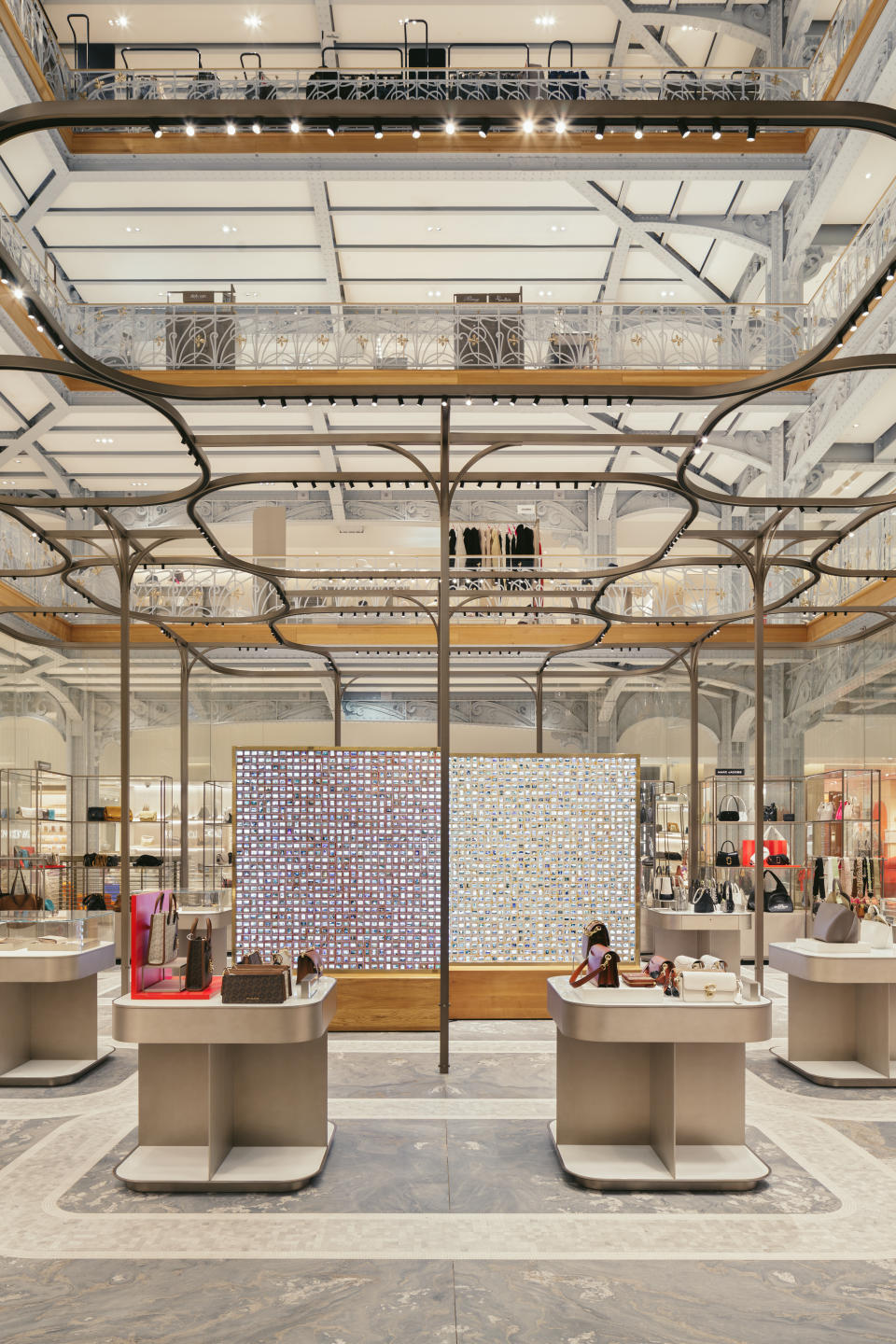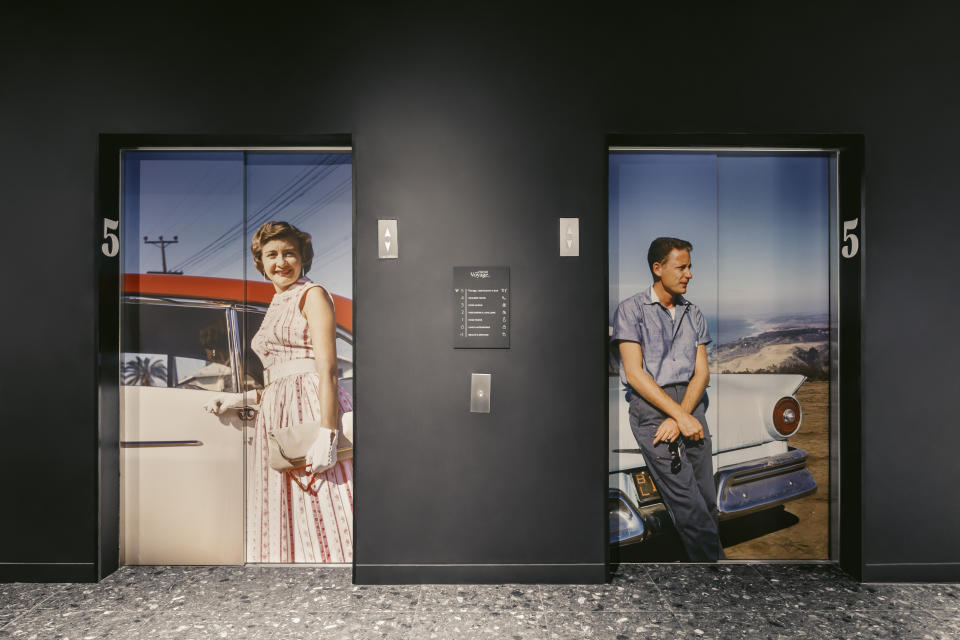The Anonymous Project Sits Just Past the Prada at Samaritaine Paris

PARIS — The Anonymous Project is sitting among a sea of name brands at Samaritaine Paris, as part of a new exhibit at the DFS-owned department store.
Below the famous arched staircase and surrounded by luxury handbags, the found photography installation from British artist Lee Shulman sees hundreds of vintage slides encased in glass and thick wood, or blown up to gigantic proportions covering the elevator banks.
More from WWD
Elsewhere, stacks of photos pour from the walls creating a waterfall of images pooling across the marble shop floor.
The handbags came in handy. When setting up the installation at 3 a.m., Shulman needed a straight line and a means of measurement. Without a yardstick, he grabbed two Pradas to use as a benchmark.
“I love it when worlds collide,” said Shulman, sporting a festive manicure of the blue, white and red French flag on one hand and the green, white and red Italian on the other.
The dual tricolors are an homage to the exhibit’s twin structure: it’s part of a joint project designed by the LVMH Moët Hennessy Louis Vuitton-owned DFS, parent company to both Samaritaine Paris and Venice’s T Fondaco Dei Tedeschi, to create a series of city exchanges.
The vitrines of the Paris store have been transformed into visions of Venice with architectural displays, while the windows in Venice have been made up as Parisian sites as part of the project, which has also spawned culinary demonstrations and seeded a cross-pollination of brands. Italian brand La DoubleJ opened its first stand-alone shop-in-shop at Samaritaine Paris with a capsule collection last month.
Travel retail operator DFS wanted to bridge the cultures of the two cities where it has stores. “It was really in our minds for a long time to play into this parallelism and contrast,” said its regional president, Europe and Middle East, Eléonore de Boysson.
“They are two incredibly emblematic and iconic buildings in each of the cities, and we wanted to show the parallel between Venice, where we give the clients a very Venetian experience with gastronomy and local brands, and the romanticism of Paris, in the heart of the city,” she added.
If a department store feels like an unusual place for an exhibit of vintage found photographs, Shulman said that it encapsulates the changing nature of art.
“Warhol said the best thing ever, that in the future, all galleries will become supermarkets, and supermarkets will become galleries, and I think he’s not far off from this idea of accessibility and giving people access to art,” he said. “Put it in the streets, put it in a shopping mall, put it in anywhere it needs to be. I think the more of it, the better.”

A department store has a demographic mixture of ages milling about. “When you’re showing images of everyday life, what better place to play? It’s the kind of place where life happens,” he said. “It’s kind of going against the grain. But maybe that’s a good thing. I’ve always said I’d like to be where you don’t expect me to be. So that’s kind of this place. If you’re in a gallery with full white wall, what’s more boring than that?”
The intimate nature of the found photos should challenge the way the public views art and artists as well, since the project blurs the line between amateur and who can be called a professional, asserted Shulman. The images were taken by regular people who were turning their lens on friends and family.
“That’s very emotionally charged,” he said, with the message being one of care and value, particularly in a time when film was more rare and difficult to develop. “[Photography] is very throwaway these days…I love the imperfections of life. These show reality. I think we’re now lost in a sort of sub-reality,” he said of today’s world of polished filters and AI-aided images.
“They have a message to tell us today. They’re important about this idea of a bigger family, and we all belong to something a bit larger than just the small thing that we concentrate on,” he said.
The images are raw and the colors saturated. He also noted that as a time capsule, the images seize a fashion moment when people dressed much more formally for everyday occasions.

For Samaritaine Paris, it’s part of a strategy to position itself as a cultural and art hub, cemented with a series of events such as last season’s hair exhibit with Charlie Le Mindu.
“It’s an experience. It gives people reasons to come back, it touches their curiosity. We are doing things to surprise, to delight the customers, to offer an experience that is much more than just shopping,” de Boysson said. There is a team dedicated to experiences which plans exhibits and sources coordinating products a year out.
De Boysson said that non-Chinese tourists have mostly returned and American tourists are roughly “double what the level was in 2019.” Chinese visitors began to return in steadier numbers this year, with the expectation they will meet pre-pandemic numbers around 2025.
In the meantime, the department store has seen an uptick in French tourists, as well as locals shopping within Paris.
The Anonymous Project exhibit will be at Samaritaine Paris until April 23, opening at T Fondaco Dei Tedeschi on April 17 to coincide with the Venice Art Biennale, with some overlapping pieces and introducing some new works in the expansive atrium there.
In Venice, there will be 12 large images printed on tissue to add an element of transparency to reflect the feeling of the original slides. There will also be a dedicated exhibition space with a 360-degree installation, with various images placed in tandem to create what appears to be a continuous horizon. It will run there until Nov. 24.
Best of WWD

 Yahoo Sports
Yahoo Sports 
